The economic speed has made the city’s construction develop rapidly. More and more large-scale buildings with strange shapes have become the new landmarks of the city. After reaching the area that is “ruled” by these markers, it is inevitable to sigh. The landmarks of these new cities are magnificent, unique or spectacular, and the tourism activities of the information age have made these new landmarks famous and famous throughout the world. Top 10 China Cities Landmark Buildings are these:
1.The Forbidden city
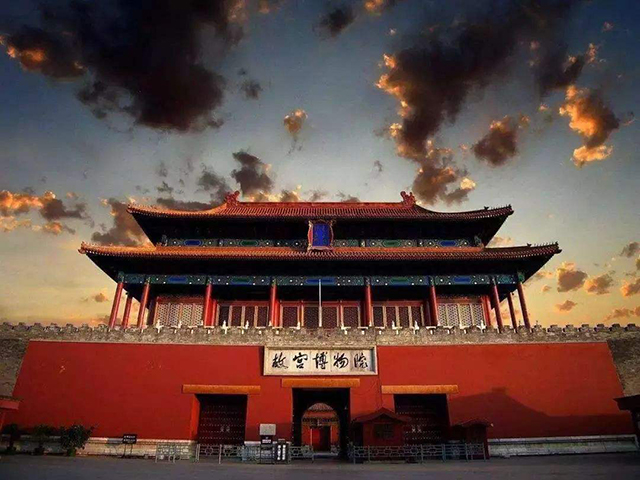
The Forbidden City is located in the center of Beijing, also known as the “Forbidden City.” There have been 24 emperors living here, the royal palaces of the Ming and Qing Dynasties (AD 1368 ~ 1911), now known as the “National Palace Museum.” The entire building of the Forbidden City is splendid and magnificent, and is regarded as one of the five major palaces in the world. It has been listed as a “World Cultural Heritage” by UNESCO. The palace building of the Forbidden City is the largest and most complete ancient architectural complex in China, with a total area of more than 720,000 square meters. It has a palace room of 9999 and a half. It is called the “sea of the temple” and is magnificent and magnificent. Whether it’s a flat layout, a three-dimensional effect, or a superb form, it is an unparalleled masterpiece. A central axis runs through the entire Forbidden City, and this central axis is on the central axis of Beijing. The four corners of the Forbidden City have exquisite turrets that are exquisitely constructed. Miyagi is surrounded by a palace wall 10 meters high and 3,400 meters long. There is a 52-meter wide moat outside the wall. In some palaces of the Forbidden City, a comprehensive historical art gallery, painting hall, classified ceramics hall, bronze museum, Ming and Qing arts and crafts museum, inscription hall, toy hall, four treasures of the Wenfang, the playhouse, the treasure hall, the watch museum and the Qing According to statistics, there are a large number of ancient art treasures. According to statistics, a total of 10,052,653 pieces, accounting for one-sixth of the total number of Chinese cultural relics, is the most abundant museum in China, and also a world-famous museum of ancient culture and art. Many cultural relics are unique and invaluable national treasures.
2.Shanghai Bund
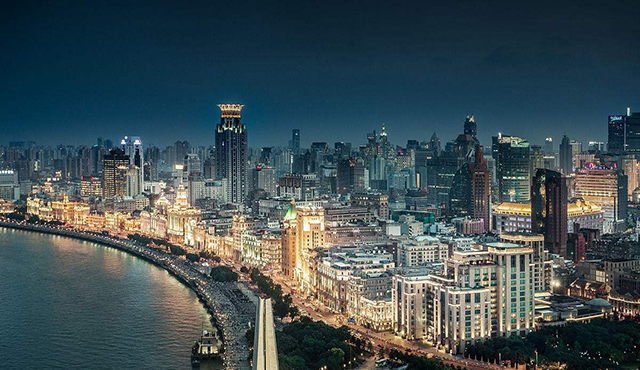
Shanghai is a representative city of modern Chinese civilization. It has a large number of historically outstanding buildings. Compared to the modern buildings in Pudong, the Bund buildings are undoubtedly more representative of Shanghai’s spiritual temperament. There are dozens of classic European styles, but they are concentrated here. It blends traditional Chinese culture. For example: Chinese peony is engraved on the colonnade. It is an experimental product of Heiner River. Although the artistic value is not inferior to the Forbidden City, but because it can not fully reflect the Chinese characteristics, this lost.
3.Lhasa, Tibet
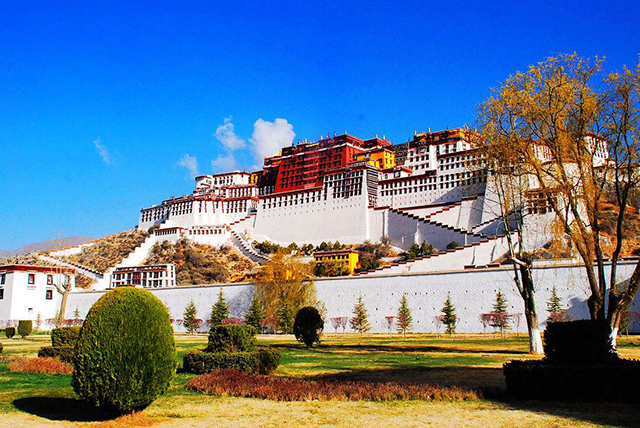
The history of architecture is much longer than the Forbidden City. Lhasa is not only a holy place in the minds of Tibetan Buddhist believers, but also a holy place in the hearts of many travelers. Lhasa is famous for its beautiful scenery, long history, splendid culture, unique customs, numerous historical sites and rich religious colors, in addition to the famous Potala Palace and the Three Great Temples of Huangjiao (Gandan Temple, Drepung Monastery, Sera Monastery). In addition to the Jokhang Temple and the Norbulingka, there are also the magical and beautiful Namtso, the romantic Yangbajing Hot Spring, etc. Visitors come here to fully experience the cultural relics and religious atmosphere that it has left over 1300 years of history. Shocked. The style is distinct and almost unique in China and the world. This is even better than the obvious national characteristics of the Forbidden City. Of course, in view of the limited influence of Lhasa itself, it ranks fourth.
4.Suzhou gardens
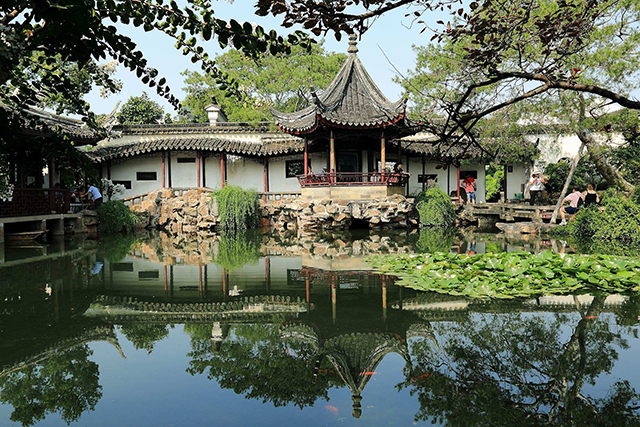
The history of Suzhou classical gardens can be traced back to the garden of Wu Wang in the spring and autumn of the 6th century BC. The private gardens were first recorded in the Eastern Jin Dynasty (4th century), and the gardens flourished in the past. During the Ming and Qing Dynasties, Suzhou became the most prosperous area in China, and private gardens were scattered throughout the ancient city. During the heyday of the 16th to 18th centuries, there were more than 200 gardens in Suzhou, and there were dozens of preserved houses, which made Suzhou a reputation as a “paradise on earth”.
There are not many buildings, but the selection is far-fetched. However, due to its special status, it is not only a world cultural heritage, but also a representative and classic of Jiangnan and even Chinese garden architecture. Suzhou has a unique business card with limited scale and exquisite elegance. As a typical example of Suzhou classical gardens, Humble Administrator’s Garden, Liuyuan Garden, Net Master Garden and Huanxiu Mountain Villa were born in the heyday of the development of private gardens in Suzhou. They have become a large number of Suzhou with its profound artistic conception, exquisite art, elegant art and rich cultural connotations. The model and representative of classical gardens.
5.Nanjing Confucius Temple
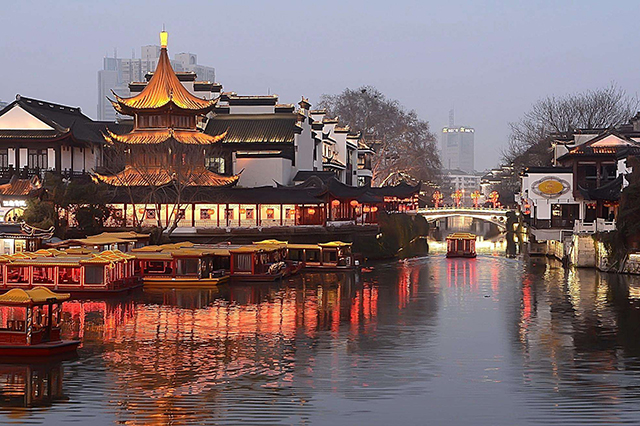
Nanjing Confucius Temple is located in Gongyuan Street on the north bank of Qinhuai River in Qinhuai District, Nanjing. It is the center of Confucius in the west of Jiangnan Gongyuan. It is the highest institution in China and the four major temples in China. It is the ancient cultural hub of China and the history of Jinling. The land of humanities is not only the cultural and educational center of Nanjing in the Ming and Qing Dynasties, but also the cultural and educational complex of the southeastern provinces. It is now an important part of the Qinhuai scenery of Confucius Temple. Confucius Temple is known as the scenic spot of Qinhuai and has become the characteristic landscape area of the ancient capital of Nanjing. It is the largest traditional ancient market in China. It is the four major cities in China with Shanghai Chenghuang Temple, Suzhou Xuanmiao Temple and Beijing Tianqiao. Confucius Temple was built in the Eastern Jin Dynasty, Emperor Sima Yan Xiankang three years (337 years), Song Jingyou first year (1034) was converted into Confucius Temple. During the Six Dynasties to the Ming and Qing Dynasties, the family of the family gathered in the vicinity, so there is the “six dynasty gold powder” Say. Hundreds of famous military strategists, politicians, and writers such as Fan Yi, Zhou Yu, Wang Dao, Xie An, Li Bai, Du Mu, and Wu Jinglian have created immortal achievements here and wrote chapters of ancient times. It is now a famous open-plan national AAAAA tourist attraction in China, and it is also a popular tourist destination.
6.Xi’an Big Wild Goose Pagoda
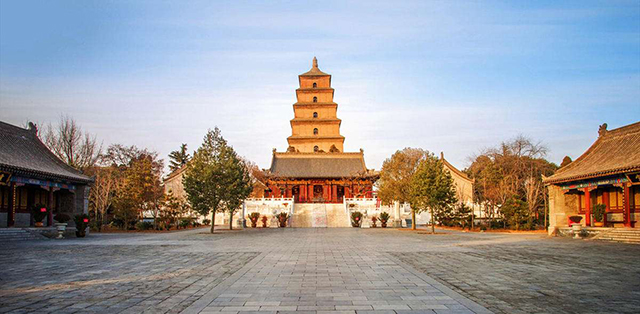
The Big Wild Goose Pagoda is located in the Dacien Temple of Jinchang Square (now in the south of Xi’an City, Shaanxi Province) in Tang Chang’an City. It is also known as the “Cien Temple Tower”. In the third year of Tang Yonghui (652), Xuanzang hosted the construction of the Big Wild Goose Pagoda for the preservation of the Buddha statues brought back to Chang’an by the Silk Road. The first five floors were added to the nine floors, and then the number of layers and heights were counted. The change was finally fixed to the seven-story tower that I saw today, with a height of 64.517 meters and a base length of 25.5 meters. The Big Wild Goose Pagoda is a typical physical evidence that the architectural form of the ancient Indian Buddhist temple, which was introduced to the Central Plains with Buddhism, and integrated into the Chinese culture.
7.Chongqing People’s Grand Hall
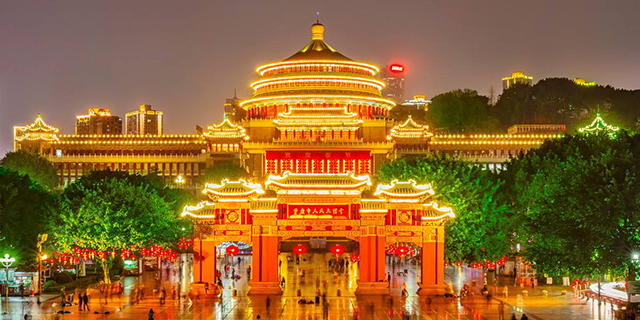
The Chongqing People’s Grand Hall was designed by the famous Chinese architect Zhang Jiade and was built at 1951.2-1954.4. It is the first large-scale building in New China with a strong ethnic style. It is a landmark building in Chongqing and has been included in the history of world architecture for its outstanding architectural achievements. It is built on the mountain, resembling the Tiananmen Square and the Temple of Heaven in Beijing, blending the traditional Chinese palace architecture with the Western architectural structure. Stepping up the steps along the 128th level, stepping in from the middle door, entering the hall in the style of the stage, looking at the golden phoenix, the road is a glimpse of the Cloud Palace. In the wide circular audience hall, nearly 4,000 seats are distributed on the fourth floor and the bottom. On the big stage, the phoenix dance lotus and the cloud pillar stand. Looking up at the dome, 36 pillars are distributed along 360 degrees, steel frame and wooden structure. One, skillful. The total height of the building is 65 meters and the medium span spans 46.33 meters. The scale is grand, magnificent and magnificent.
8.Hong Kong Bank of China Building
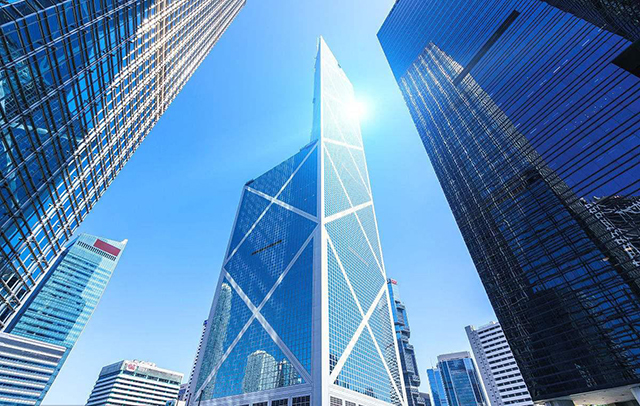
Pei’s masterpiece, the artistic value is even above Jinmao. As Hong Kong is everywhere, it is a rare high-rise building. It can be regarded as avant-garde style, unique shape, and the symbol of Hong Kong.
9.Shenzhen Diwang Building
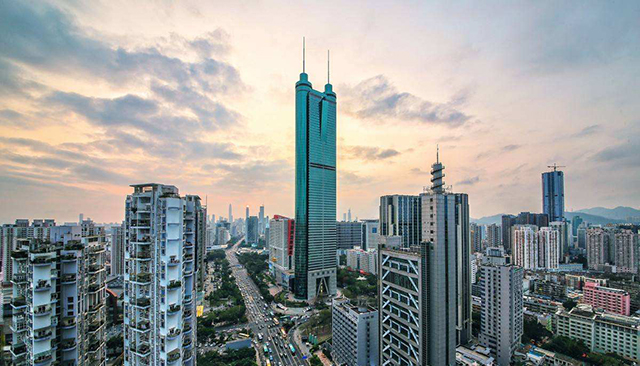
Diwang Building, located in Shennan Zhong Road. It is 420 meters high and has 81 floors. Completed in 1996. When it was built, it was the tallest building in Asia and the first high-rise building in the country. It ranks among the top ten buildings in the world.
10.Macau St. Paul’s Memorial
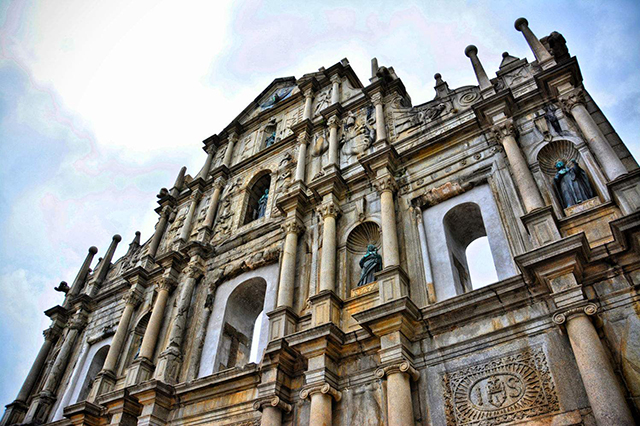
The Sanba Memorial is the ruins of the front wall of St. Paul’s Church and is a famous landmark in Macau.
The church was originally designed by an Italian Jesuit priest and was built with the help of Japanese craftsmen. The foundation stone was laid in 1602, and all were completed in 1637, while the long stone steps in front of the church were completed later. This church and the fire are inextricably linked. Starting from its embryonic form, the only remaining ruins of the front wall have experienced three major fires and repeated burning and repeated construction. It is a living historical witness. At dusk on January 26, 1835, St. Paul’s Church caught fire and was out of control. It burned for more than two hours. The whole church was almost destroyed. Fortunately, the most precious front wall of the church can still be preserved and become a junior. The Pakistani archway was repaired several times during the period, and a large-scale maintenance project was carried out in 1991. The architecture of St. Paul’s Church is a combination of European Renaissance and Oriental architecture. The combination of Chinese and Western styles and fine carvings is the cost of the Ruins of St. Paul’s. It has reached 30,000 silver three hundred years ago.